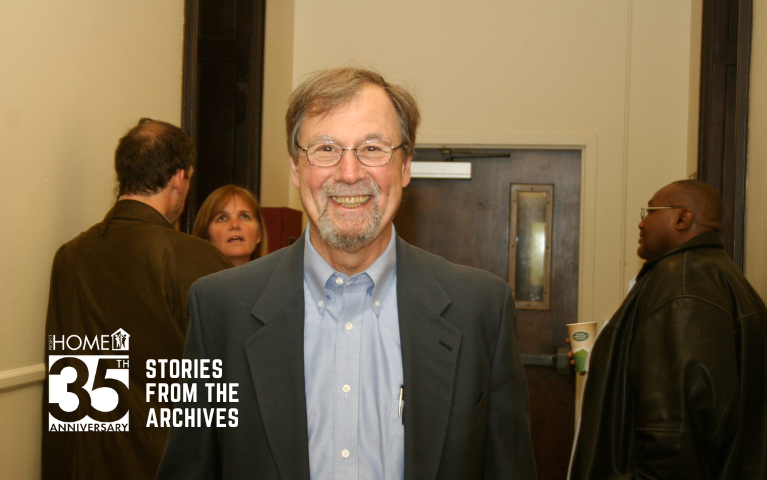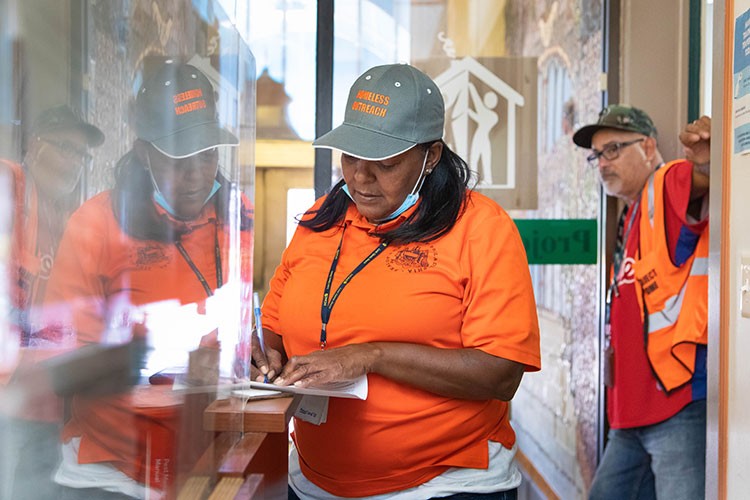Stories From The Archives: The Doors To Project HOME

During our 35th anniversary year, we are digging into our deep archives to share stories from our past that highlight some of the many milestones we have celebrated over our nearly four decades of service to Philadelphia.
The following reflection from a 2006 issue of our former newsletter, Dwelling Place, is from Ed Speedling, a long-time Project HOME outreach worker. Ed, who has since passed away, still sets an example of compassion and empathy for the Project HOME community.
Outreach is where many journeys home begin, and Ed's piece below beautifully captures that.
...
People often ask me how they can get connected with Project HOME There are, of course, a number of ways to get in touch with us: telephone, email, stopping by one of our houses.
When I recall my own experience, the beautiful entranceway into 1515 Fairmount Avenue stands out for me. So impressive are those fabulous brass doors that open to a foyer whose walls literally speak – no, they shout out – a message of hope and a promise of friendship to all who would come forth. Surely, these doors have been a passageway to reconciliation and recovery for thousands of people. And this is their real value – what they lead people to – not what they are made of or how great they might look.
In fact, I have discovered other doors to Project HOME, and some of them are in dark and lonely places. These doors have a special quality – they don’t exist in the same way that the doors of 1515 Fairmount Avenue exist. They only come into being through energy created by people caring for one another.
The Door on an Empty Street
Taking a census of homeless people on the streets of Philadelphia during the winter is tough. The late night wind chill makes looking for folks hard; coming upon someone choosing the cold concrete over a shelter bed is even harder. Jim, a Project HOME Trustee, and I were on a street in Old City at about 2 a.m. when we saw him. He was walking slowly along the street, belongings in hand, shivering against the cold wind.
We called to him. He picked up his pace.
We called again, “Hey, we’re from Outreach, Project HOME How are you doing?” He suddenly stopped and turned, stared at us for a few seconds, crossed the street and came toward us like a man on a mission.
Looking me straight in the eye, he said his name was Tattoo Eddie and he was able to take care of himself, that he was a survivor on the streets, and wanted nothing at all from outreach. All he needed right then was a pair of gloves.
He would spend the night in a subway station. We gave him the gloves we were wearing. He thanked us and turned to leave, “Here take this.” I said and handed him a Project HOME card. “Come in when you have the time. We can talk.”
He took the card, waved to us and left. Both Jim and I thought, “Good luck, Tattoo Eddie.” Little did we know that a door had opened for him on that cold sidewalk in Old City. The very next day that survivor called the Outreach office and asked for help. Outreach worker Tim Jones responded to the call, and that night Tattoo Eddie did not sleep in the subway. He had a bed and a place to rest.
The Door in Suburban Station
One morning I received a message that Terry, a young woman who commutes to work each morning from New Jersey, needed some assistance.
I called her and learned that for months she had been developing a relationship with an elderly homeless man in Suburban Station. Each morning she would stop for a few minutes to talk to him and before long, casual conversation blossomed into mutual affection and friendship. She learned that this gentleman was a seafaring man, a veteran, and a wanderer. The Outreach Coordination Center (OCC) was very familiar with him, but our outreach workers were unable to establish a relationship.
When approached by one of us, he would tell us, in very salty language, to hoist anchor and take off. Terry said she thought he was ready now, and that with encouragement from her, and a little assistance from us, this wandering man might agree to leave the streets and come inside. The next morning at 5:00 am, two of our outreach staff met Terry and her friend, and a door opened.
That morning, St. Columba received a new resident, and the Project HOME community was all the richer for it.
The Door Under the Bridge
“I lost everything to drugs.” This young man looked like someone who lost more than his job and his possessions. Sitting in the outreach office he told a sad tale of addiction, and of the costs to him and his family. But he became most despondent when he admitted that yesterday, having nothing more to sell, no one else to give him money for the fix he craved, he decided to rob someone. The thought horrified him, but the craving was overwhelming. In a panic, the young man wandered the streets and came to a bridge.
Underneath, he happened upon a stranger sitting there and told him his dilemma. Sharing his need with a stranger allowed a door to open. He heard the man say, “Go to 1515 Fairmount Avenue and see if they can help you.” After the intake assessment was completed, the young man was introduced to Laurence Dixon, OCC worker. Laurence made a few calls, and a plan was hatched to link the young man to a drug treatment program.
Doors are entrances that mark a beginning. Each of these individuals walked through a door to Project HOME and into the possibility that a journey would begin. Journeys can be long and winding.
Some are easier than others.
But all have to start somewhere.
